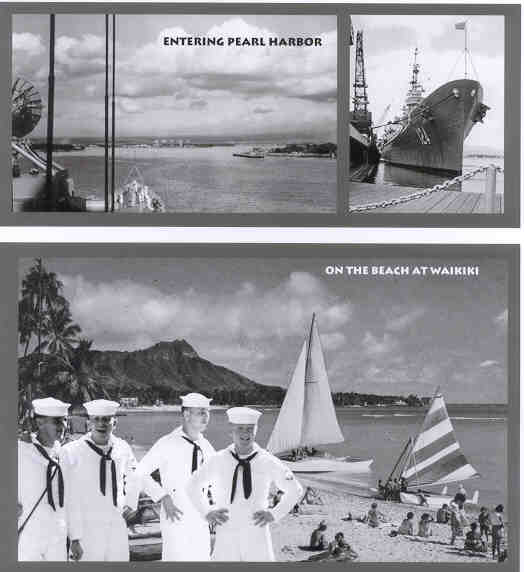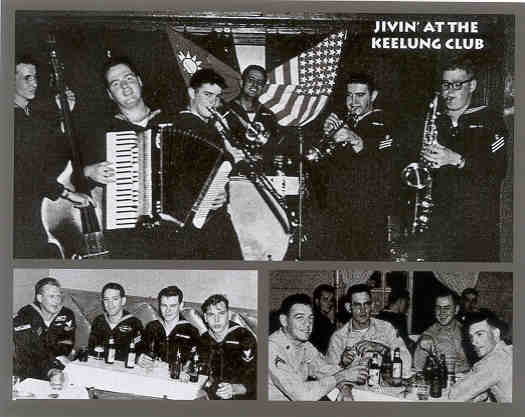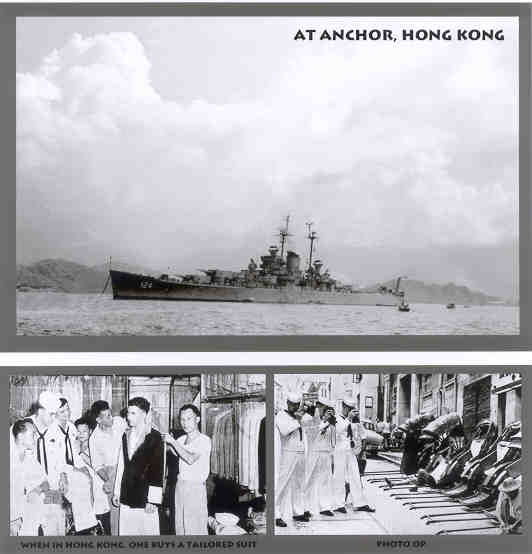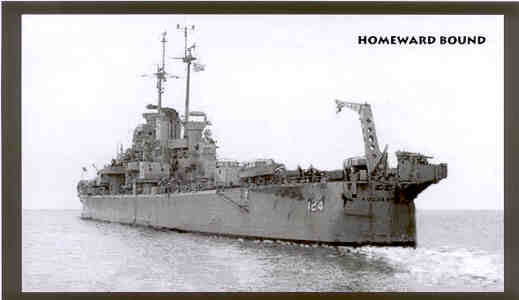1955 Cruise to the Western Pacific…
With hostilities in Korea locked in an extended truce, the focus of concern in the Far East during 1955 shifted south to the Island of Taiwan. The Chinese Nationalists had taken refuge there after being driven from the Mainland by Communist insurgents in 1949, but they faced an uncertain future. All that separated them from being overwhelmed by a more powerful enemy was a narrow stretch of water—the Taiwan Strait.
The United States recognized the Nationalists on Taiwan as the legitimate representatives of China and had ratified a Mutual-Defense Agreement with that government in 1954. So when ROCHESTER steamed westward across the Pacific in February of 1955, it was with orders to join elements of the U. S. 7th Fleet positioned to discourage Communist aggression across the Taiwan Strait. The article that follows is based on materials in ROCHESTER’s 1955 Cruise Book.
As an effective show of force, the 7th Fleet engaged in exercises designed to display U. S. Naval strength. Ships involved in these exercises were designated Task Force 77 (as were ships of the 7th Fleet operating off Korea during that conflict). The operation extended over a broad expanse of the western Pacific between Japan and the Philippine Islands. Taiwan was at the center, With Keelung, at the Island’s northern end, becoming ROCHESTER’s homeport.
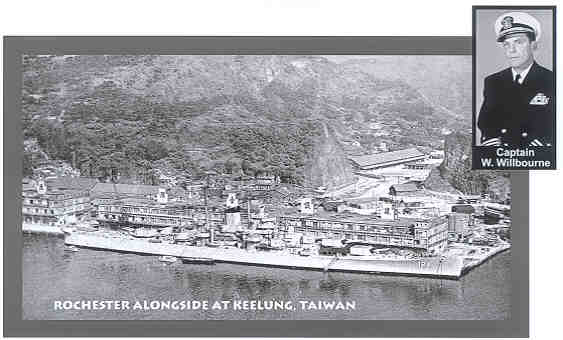
Upon arriving at Keelung early in March, ROCHESTER took aboard the Admiral in command of the Fleet and his staff, so that upon putting to sea several days later it was as 7th Fleet flagship.
Getting Underway
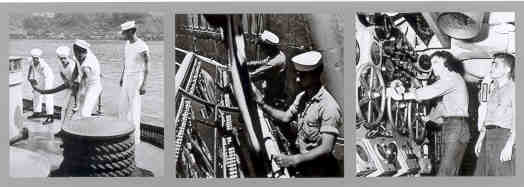
Special Sea Details, manned by those most proficient in tasks involved in putting to sea, were set 45 minutes before the mooring lines were brought aboard. As ROCHESTER maneuvered toward open water, Signalmen on the Signal Bridge ran up various combinations of flags and pennants that kept nearby vessels and shore stations aware of the ship’s intentions. And below in the engine room, the main-engine throttleman awaited Captain’s orders to “step on the gas”.

The Navigator kept a precise plot of the ship’s position based on bearings of charted objects on shore taken by Quartermasters on the Navigation Bridge, while in the Pilot House the Helmsman kept the ship on courses called down through a voice tube by the Officer-of-the-Deck on the Open Bridge. Once ROCHESTER had entered open water, the Special Sea Details were relieved by regular watch standers.
At Sea

Being 7th Fleet flagship greatly increased the need to communicate with other units. Radio traffic surged, keeping Radiomen of OR Division busy, and when circumstances called for radio silence, or when the message recipient was nearby, Signalmen of OS Division stood ready to perform with flashing light or semaphore.
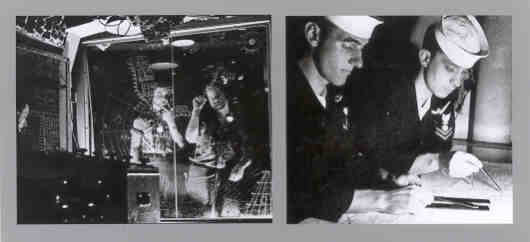
In Combat Information Center, a dimly lit compartment deep below decks (above left), Radarmen of K Division plotted and interpreted the many contacts received by the ship’s search radar. Targets potentially crucial to operation success included nearby landforms, other ships and approaching aircraft. In the Chart House (right), the Quartermaster on watch kept the Officer of the Deck aware of the ship’s position by plotting a Dead Reckoning Tract (based on course and speed) from the Navigator’s last celestial or LORAN fix

Engineering watch-standers carefully monitored the production of power that drove the ship. Here (above left), the temperature of the main-engine bearings is noted, while (on the right) a Boiler Tender watches to ensure that boiler water is at a proper level.
Much on-board activity was directed at servicing the crew
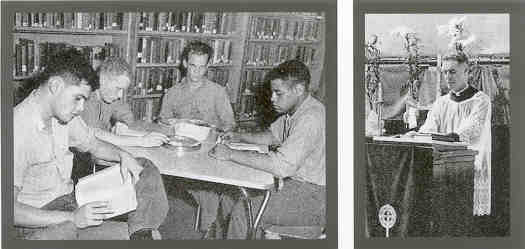
After working hours, off-watch personnel were free to relax in the ship’s library or engage in other recreational activities. The Chaplain held Mass daily and general Services on Sundays
WITH TASK FORCE 77

Task Force 77 performed maneuvers that were, technically, training exercises, but time and place implicated intent to intimidate the Red Chinese

Splash one! A radio-controlled target drone is shown above falling into the sea, downed by fire from one of ROCHESTER’s 3-inch mounts. The 3-inch battery, the ship’s primary defense against attacking aircraft, proved more effective than the batteries they had replaced—the 20 and 40 mm batteries of the Korean-War era
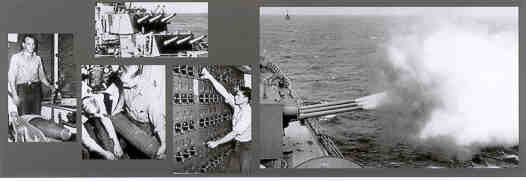
ROCHESTER’s offensive weapon’s—the 5” and 8” batteries—were her reason for being. Actions involved in propelling projectiles from her main battery—8” rifles in turrets 1, 2 and 3—are shown above. At the far left, an 8” projectile, followed by bags of powder, is loaded into a rifle’s breech. These actions occurred in the turrets, but the rifles were leveled into firing position by Fox Division personnel in plot (center photo). There, an array of knobs and switches allowed Fire Controlmen to integrate variables that influence projectile trajectory, including target distance, ship’s course, wind and air temperature. Once the rifle had been positioned, the powder was ignited and the projectiles sent on their way (basically the same way cannon balls were propelled from wooden ships in the 16th century). The accuracy of fire from ROCHESTER was widely recognized during her three tours of Korean-War duty
PORTS OF CALL
There was a strong effort to fulfill the promise implicit in the recruiting slogan “Join the Navy and See the World”. Although constrained within limits set by the operating schedule, ROCHESTER put liberty parties ashore at Pearl Harbor, Yokosuka, Keelung, Manila and Hong Kong. An overnight stay at Okinawa provided time only for swim call.
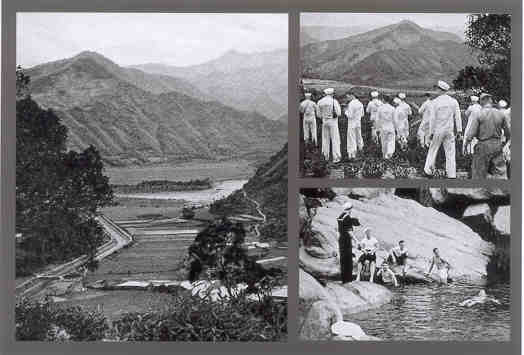
Taiwan was long known to Westerners as Formosa, after a 16th century Dutch Navigator exclaimed “Ilha Formosa” (“Beautiful Island”) upon first viewing its striking topography. Many ROCHESTER crewmen appreciated the spectacular scenery

The Walled City, rich in history, was among highlights for many sailors on liberty in Manila. During WWII it was heavily fortified by Japanese defenders and extensively damaged by American airmen. On the right, kids flock to a ROCHESTER sailor amid Walled-City ruins
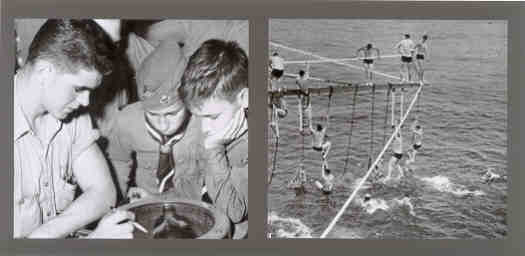
OKINAWA (12-13 June) On 12 June, ROCHESTER detoured from Task Force 77 duties to transport 57 Boy Scouts from Keelung to Okinawa, site of a multi-region summer encampment—a reminder that even in militarily tense times, life goes on. Above, two scouts are shown a radar sweep. It was just an overnight stay at Okinawa, but the crew was given time there for a dip in the Pacific
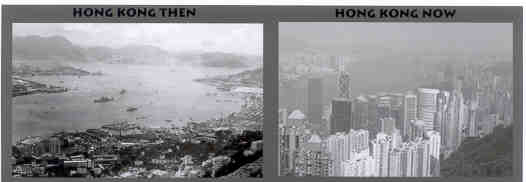
Hong Kong’s economy has boomed since ROCHESTER’s 1955 visit. This is evident in the two photos above (1954 and 2002, both views from the same location)
Job Well Done!
ROCHESTER was relieved of WESTPAC duties on 6 August and headed eastward across the Pacific toward home. It had been a job well done. Without the 7th Fleet standing guard during her formative years, Taiwan would have been assimilated into Communist China as an early casualty of the Cold War. Instead, with the U. S. Navy blunting repeated communist threats during the years that followed, Taiwan prospered to become one of the world’s strongest economies. In 1955, however, the task of guarding the Taiwan Strait had just begun.





